We are currently living a special moment in time, a sort of paradox.
Today, almost half of the world’s population already has Internet access. This figure is much higher than anything we could have anticipated 10 years ago, an achievement we should be happily celebrating.
But a recent report by the Internet Society, Paths To Our Digital Future, shows there are no guarantees when it comes to the Internet’s future. To achieve a digital future where people come first will require new thinking, new approaches, and new tools for this rapidly changing world around us.
And with this we find ourselves facing an even greater challenge. This is no longer the Internet of 10% of the world’s population. It is the Internet of 50% of the people around the world; in some countries, Internet penetration is now close to 100%.
The Internet has become essential, and the opportunity gap between those who are connected and those who are not is growing each day. We cannot afford to remain indifferent to this Internet revolution.
If we don’t connect the remaining 50%, this gap could have long-term consequences for the opportunities that present themselves later in life.
After the United Nations adopted the Sustainable Development Goals (SDGs) in 2015, discussions on the digital divide have become more concrete and have gained greater visibility. We are no longer talking just about connecting people, but about how we use the Internet and ICTs to achieve development goals in education, health care, employment, gender equality, and other areas.
If we do not make further progress in Internet development, we will not make progress in bringing benefits such as universal education and access to healthcare services. We will not make progress towards achieving the SDGs, which will affect the ability for people to improve their quality of life. In the end, it’s all about people and people should be at the heart of our work.
Next week, the Internet Society will be participating at the World Telecommunication Development Conference (WTDC). Government, private sector, and civil society representatives from around the world will meet for this significant international conference organized by the International Telecommunication Union (ITU), in Buenos Aires, Argentina.
This is where critical work must happen. Policy and decision makers will meet from around the world to make decisions about the future of things like Internet access.
It is critical that the world send a clear message that we need a digital future where humanity is at the heart of the Internet. And for that to happen will require new thinking, new approaches, and new tools for this rapidly changing world around us.
An example of this can be seen in something known in the Internet world as “Community Networking.” Community Networks are typically built so some of the worlds hardest-to-reach places can connect. Many of them are, in a way, “homemade.” In fact, one of their most exciting commonalities is they can be built by anyone, regardless of technical background
Community Networks are a clear example of what we need more of. We need world leaders to stand behind them and support policies that can make them happen. Especially when we participate along with governments that can help scale activities and make changes to old policies – changes that innovate to enable infrastructure development.
Countries that don’t design and implement concrete strategies for Internet development and Internet-based development may not be able to fully achieve their sustainable development goals, seriously compromising their future.
This is a great opportunity for governments, an opportunity that should not be wasted. An opportunity for sharing experiences, for setting aggressive goals – the time for modest goals is long gone – and for making sure that legal, regulatory and political frameworks will be catalysts and enablers of development, not obstacles hindering its progress.
It’s time to move forward. Together we can tell policies and decision makers it’s time to #ShapeTomorrow and give the world the tools it needs to achieve the SDGs.

